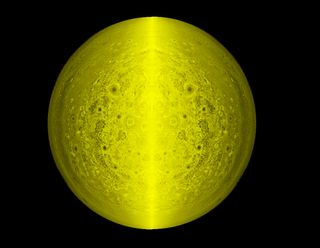Smiley Face on Jupiter Wants You to Have a Nice Day (Photo)

Jupiter appears to be flashing a big smile at the solar system, in an image that was created using data from NASA's Juno spacecraft.
On Aug. 27, the probe made a close pass by Jupiter, and an instrument called the JunoCam took some snapshots of the half-lit planet. Those data are made available to the public, and citizen scientist Randy Ahn mirrored the image to create a fully illuminated circle. He then processed the image in such a way as to give it the yellow tint, and bring out features that seem to create two eyes and a smiling mouth.
The Juno probe is scheduled to make a series of close flybys of Jupiter from now through February 2018. The Aug. 27 flyby was the first time the probe flew close to the planet with its instruments turned on. The probe gets to within 3,100 miles (5,000 kilometers) of Jupiter's cloud tops, which is the closest any probe has ever come to Jupiter. [Amazing Jupiter Photos by NASA's Juno]
The JunoCam instrument's primary purpose is to engage the public and send back images of the planet that are taken in visible wavelengths of light (those that the human eye can see). Different image-processing techniques conducted by other citizen scientists have highlighted different features on Jupiter, including many swirling storms.
Scott Bolton, Juno's principal investigator, from the Southwest Research Institute in San Antonio, announced some early results from the Aug. 27 flyby at the 2016 meeting of the American Astronomical Society's Division for Planetary Sciences in Pasadena, California. But Bolton said that any deep scientific analysis is yet to come. Juno was supposed to fire its engines on Oct. 19 in order to shorten its orbit around Jupiter from 53 days to 14 days, but a problem with the engine valves has delayed that maneuver indefinitely.
Follow Calla Cofield @callacofield. Follow us @Spacedotcom, Facebook and Google+. Original article on Space.com.
Get the Space.com Newsletter
Breaking space news, the latest updates on rocket launches, skywatching events and more!
Join our Space Forums to keep talking space on the latest missions, night sky and more! And if you have a news tip, correction or comment, let us know at: community@space.com.

Calla Cofield joined Space.com's crew in October 2014. She enjoys writing about black holes, exploding stars, ripples in space-time, science in comic books, and all the mysteries of the cosmos. Prior to joining Space.com Calla worked as a freelance writer, with her work appearing in APS News, Symmetry magazine, Scientific American, Nature News, Physics World, and others. From 2010 to 2014 she was a producer for The Physics Central Podcast. Previously, Calla worked at the American Museum of Natural History in New York City (hands down the best office building ever) and SLAC National Accelerator Laboratory in California. Calla studied physics at the University of Massachusetts, Amherst and is originally from Sandy, Utah. In 2018, Calla left Space.com to join NASA's Jet Propulsion Laboratory media team where she oversees astronomy, physics, exoplanets and the Cold Atom Lab mission. She has been underground at three of the largest particle accelerators in the world and would really like to know what the heck dark matter is. Contact Calla via: E-Mail – Twitter
